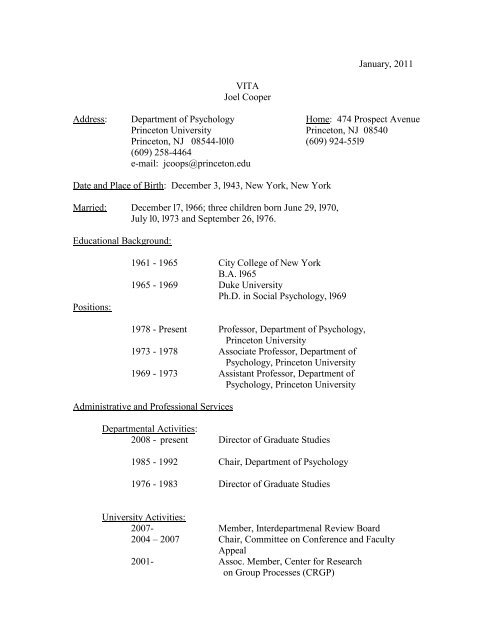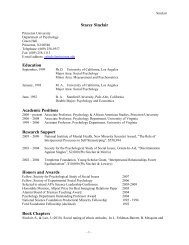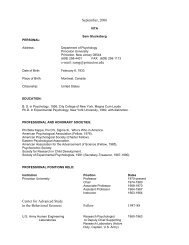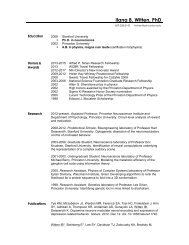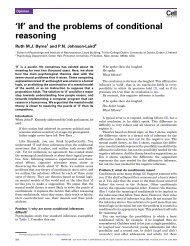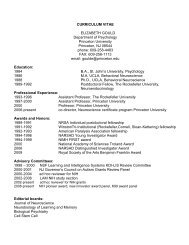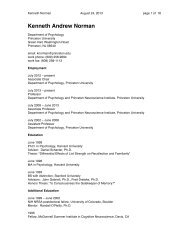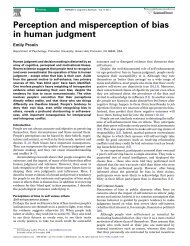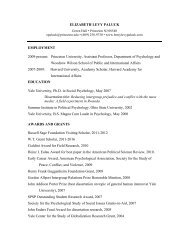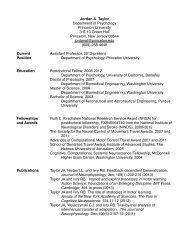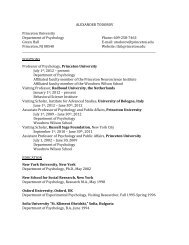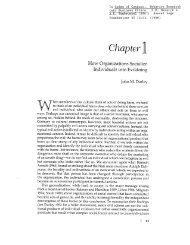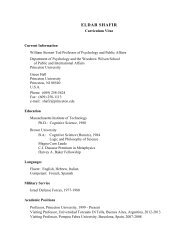VITA Joel Cooper - Princeton University - Department of Psychology
VITA Joel Cooper - Princeton University - Department of Psychology
VITA Joel Cooper - Princeton University - Department of Psychology
Create successful ePaper yourself
Turn your PDF publications into a flip-book with our unique Google optimized e-Paper software.
January, 2011<strong>VITA</strong><strong>Joel</strong> <strong>Cooper</strong>Address: <strong>Department</strong> <strong>of</strong> <strong>Psychology</strong> Home: 474 Prospect Avenue<strong>Princeton</strong> <strong>University</strong> <strong>Princeton</strong>, NJ 08540<strong>Princeton</strong>, NJ 08544-l0l0 (609) 924-55l9(609) 258-4464e-mail: jcoops@princeton.eduDate and Place <strong>of</strong> Birth: December 3, l943, New York, New YorkMarried: December l7, l966; three children born June 29, l970,July l0, l973 and September 26, l976.Educational Background:Positions:1961 - 1965 City College <strong>of</strong> New YorkB.A. l9651965 - 1969 Duke <strong>University</strong>Ph.D. in Social <strong>Psychology</strong>, l9691978 - Present Pr<strong>of</strong>essor, <strong>Department</strong> <strong>of</strong> <strong>Psychology</strong>,<strong>Princeton</strong> <strong>University</strong>1973 - 1978 Associate Pr<strong>of</strong>essor, <strong>Department</strong> <strong>of</strong><strong>Psychology</strong>, <strong>Princeton</strong> <strong>University</strong>1969 - 1973 Assistant Pr<strong>of</strong>essor, <strong>Department</strong> <strong>of</strong><strong>Psychology</strong>, <strong>Princeton</strong> <strong>University</strong>Administrative and Pr<strong>of</strong>essional Services<strong>Department</strong>al Activities:2008 - present Director <strong>of</strong> Graduate Studies1985 - 1992 Chair, <strong>Department</strong> <strong>of</strong> <strong>Psychology</strong>1976 - 1983 Director <strong>of</strong> Graduate Studies<strong>University</strong> Activities:2007- Member, Interdepartmenal Review Board2004 – 2007 Chair, Committee on Conference and FacultyAppeal2001- Assoc. Member, Center for Researchon Group Processes (CRGP)
2001- 2002 Interim Master, Mathey College1999 - 2000 Interim Master, Mathey College2003 Seminar, Superintendents as Scholars2002 Seminar, Principals as Scholars2000 Seminar, Teachers as Scholars1998 - 2006 Interdepartmental Committee for Program inApplications for Computing1996 - 1999 Chair, Institutional Review Board1984 - 1987 Chair, Institutional Review Board1974 - 1981 Member, Institutional Review Board1994 - 1998 Priorities Committee1994 - 1995 Management Development Task Force1993 - 1998 Member, Committee on Committees1992 - 1995 Member, <strong>University</strong> Research Board1990 - Interdepartmental Committee forProgram in Teacher Preparation1989 - 1996 Science and Technology Council2000- 2004 Interdepartmental Program Committee onHuman Information Processing Group1986 - 1999 Director, Human InformationProcessing Group1988 - Fellow, Forbes College1988 - Fellow, International Center1980 - Fellow, Graduate College1989 - 1991 Advisory Committee on Athleticsand Physical Education1989 - 1990 Chairman, <strong>Princeton</strong> <strong>University</strong> UnitedWay Campaign1988 - 1989 Member, <strong>University</strong> Committee on theScience Requirement1988 - 1992 Member, President's Review Panelfor <strong>University</strong> Grievance Procedurefor Administrative and Staff Employees1988 - 1989 Member, Faculty Equal EmploymentOpportunity Committee1982 - 1983 Member, Faculty Committee on1984 - 1987 Appointments and Advancements1988 - 1989 Appointments and AdvancementsOutside Activities:2006 - present Chair, NIH Special Emphasis Panel for Pre and PostDoctoral Fellowships2000 - 2005 Ad hoc Member, NIH Scientific Review Panel2001 Member, NIH Training Grant Review Panel1999 NSF Special Advisory Panel for the Social/Behavioral Science Infrastructure Competition.1999 Facilitator <strong>of</strong> Self Study Retreat, NYU2
1995 - Advisory Board, Science for Pr<strong>of</strong>essionals, Inc.1993 Ad hoc member, Social and Group ProcessReview Committee, NIMH1993 Member, Center for Substance AbuseTreatment Review Branch, NIMH1991- Member, Syndrome Research ReviewCommittee, NIMH1990 - 1992 President, <strong>Princeton</strong> RegionalBoard <strong>of</strong> Education1984 - 1990 and Member, <strong>Princeton</strong> Regional Board <strong>of</strong>1981 - 1982 Education1990 - 1991 Review Group <strong>of</strong> Texas Higher EducationCoordinating Board1990 - 1991 Member, NIMH Workshops:Maintenance Mechanisms <strong>of</strong> Maladaptive Behaviors1989 - Consultant, Directory <strong>of</strong> New JerseyConsultants in Teaching and Learning1989 NIMH Special Committee on Social andInterpersonal Processes and Health1988 - 1989 Chair, Behavioral Science Review Panel,National Institute <strong>of</strong> Mental Health1986 - 1987 Chair, Executive Committee <strong>of</strong> theSociety <strong>of</strong> Experimental Social <strong>Psychology</strong>1985 - 1988 Member, Behavioral Science ReviewPanel, National Institute <strong>of</strong> Mental HealthFellowships and Visiting Positions:Research Interests:2000 – 2001 Visiting Distinguished Pr<strong>of</strong>essor, Queensland<strong>University</strong>, Brisbane, Australia1995 – 1996 Visiting Pr<strong>of</strong>essor, Queensland <strong>University</strong>,Brisbane, Australia1983 Lady Davis Fellow, Hebrew <strong>University</strong>, Jerusalem,Israel1978 Visiting Pr<strong>of</strong>essor, <strong>University</strong> <strong>of</strong> Auckland, NZ1975 Senior Fellow, East-West Population Inst.East-West Center, Honolulu, HI1972 Visiting Lecturer, <strong>University</strong> College London,London, EnglandAttitudes, attitude change, cognitive dissonance theory, socialpsychological processes in psychotherapy, social impact <strong>of</strong>computer technology, computer use and gender, psychology and law.3
Research Support:Current:Previous:submitted to National Institutes <strong>of</strong> Health: Reducing Health Risksvia Vicarious Cognitivie Dissonance (R01-CA097354-04A2)National Institutes <strong>of</strong> Health – Vicarious Dissonance, AttitudeChange and Social Identity. RO1-CA097354-01 (8/02 – 7/06)National Science Foundation -- Investigation <strong>of</strong> theInquisitiorial and Adversarial Legal Modes <strong>of</strong> AdjudicationScientific/Technological Testimony, 1996-1997James S. McDonnell Foundation -- Motivation andHuman Computer Interaction, 1986-1996.National Science Foundation -- Effects <strong>of</strong> ExpertScience and Technology Testimony in the LegalSystem, 1994-1996.National Science Foundation -- CognitiveDissonance and Psychotherapy.National Institute <strong>of</strong> Mental Health -- AversiveConsequences and Personal Responsibility inCognitive Dissonance.Reviewer:Office <strong>of</strong> Education – Self Fulfilling Prophecy in the ClassroomAustralian Research CouncilBasic and Applied Social <strong>Psychology</strong>Journal <strong>of</strong> Educational Computer ResearchJournal <strong>of</strong> Experimental Social <strong>Psychology</strong>Journal <strong>of</strong> PersonalityJournal <strong>of</strong> Personality and Social <strong>Psychology</strong>Personality and Social <strong>Psychology</strong> Bulletin – Consulting EditorSocial <strong>Psychology</strong> QuarterlyOrganizations:American Psychological Association - FellowAmerican Psychological Society - FellowAmerican Association for the Advancement <strong>of</strong> ScienceAmerican Association <strong>of</strong> <strong>University</strong> <strong>of</strong> Pr<strong>of</strong>essorsSociety <strong>of</strong> Experimental Social PsychologistsSociety <strong>of</strong> the Psychological Study <strong>of</strong> Social Issues - FellowSociety for Personality and Social <strong>Psychology</strong>4
Books:Forgas, J. , <strong>Cooper</strong>, J. and Crano, W. (Eds). (2009). The <strong>Psychology</strong> <strong>of</strong> Attitudesand Attitude Change. London, <strong>Psychology</strong> Press.Hogg, M. A., & cooper, J. (Eds.). (2007). The Sage Handbook <strong>of</strong> Social<strong>Psychology</strong>, London: Sage.<strong>Cooper</strong>, J. (2007). Cognitive Dissonance: 50 years <strong>of</strong> a classic theory. London,Sage.<strong>Cooper</strong>, J. & Weaver, K. D. (2003). Gender and computers: Understanding thedigital divide. Mahwah, NJ: Erlbaum.Hogg, M. A. & <strong>Cooper</strong>, J. (Eds.) (2003). Sage handbook <strong>of</strong> social psychology.London, UK: Sage.Worchel, S., <strong>Cooper</strong>, J., Goethals, G. & Olson, J. (2000). Social psychology.Chicago, IL: Nelson-Hall.Darley, J.M. & <strong>Cooper</strong>, J. (Eds.) (1998). Attribution processes, personperception, and social interaction: The legacy <strong>of</strong> Edward E. Jones, AmericanPsychological Association: Washington, DCWorchel, S., <strong>Cooper</strong>, J. & Goethals, G.R. (1991). Understanding socialpsychology, (5 th ed). Homewood, IL: The Dorsey Press.Book Chapters:<strong>Cooper</strong>, J. (2009). Riding the D-Train with Elliot: The Aronsonian Legacy <strong>of</strong>Cognitive Dissonance.<strong>Cooper</strong>, J. (2009). Vicarious cognitive dissonance: Changing attitudes byexperiencing another’s pain. In Forgas, J. et al. The <strong>Psychology</strong> <strong>of</strong> Attitudes andAttitude Change. London: <strong>Psychology</strong> Press.<strong>Cooper</strong>, J. & Kugler, M. B. (2007). The digital divide: The role <strong>of</strong> gender inhuman computer interaction. In J. A. Jacko and A. Sears (Eds.) The humancomputerinteraction handbook: Fundamentals, evolving technologies andemerging applications (pp. 763-776). New York:Erlbaum.<strong>Cooper</strong>, J., & Hogg, M. A. (2007). Feeling the anguish <strong>of</strong> others: A theory <strong>of</strong>vicarious dissonance. In M. P. Zanna (Ed.) Advances in Experimental Social<strong>Psychology</strong>, (Vol. 39.) San Diego, CA: Academic Press.5
<strong>Cooper</strong>, J., Mirabile, R. R. & Sher, S. J. (2005). Actions and attitudes: Thetheory <strong>of</strong> cognitive dissonance. In T. C. Brock & M. C. Green (Eds.). Persuasion:Psychological insights and perspectives, (2 nd Ed.). Thousand Oaks, CA: SagePublications.<strong>Cooper</strong>, J. (2004). Dissonance theory: History and progress. In R. A. Wright, J.Greenberg & S.S. Brehm (Eds.). Motivation and emotion in social contexts: JackBrehm’s influence on contemporary psychological thought. Mahwah, NJ:Erlbaum.Visser, P. & <strong>Cooper</strong> J. (2003). Attitude change. In M. A. Hogg & J. <strong>Cooper</strong>(Eds.). Sage handbook <strong>of</strong> social psychology. (pp. 211-231). Cambridge: SagePublications.<strong>Cooper</strong>, J. & Hogg, M. A. (2002). Dissonance arousal and collective self. In J. PForgas, & K. D. Williams (Eds.). The social self: Cognitive, interpersonal andintergroup perspectives. New York: <strong>Psychology</strong> Press.<strong>Cooper</strong>, J. (2001) Interpersonal processes: Persuasion and attitude change. In M.A. Hogg, & J. <strong>Cooper</strong> (Eds.). Sage handbook <strong>of</strong> social psychology. London, UK:Sage.<strong>Cooper</strong>, J., Kelly, A. K. & Weaver, K. (2001). Attitude norms, and social groups.In M. A. Hogg & R. S. Tindall (Eds.). Blackwell handbook <strong>of</strong> social psychology,(Vol. 3). Malden, MA: Blackwell.<strong>Cooper</strong>, J. (2001). Motivating cognitive change: The self-standards model <strong>of</strong>dissonance. In J.P. Forgas, K. D. Williams & L. Wheeler (Eds.). The social mind:Cognitive motivational aspects <strong>of</strong> interpersonal behavior. New York: Cambridge<strong>University</strong> Press.<strong>Cooper</strong>, J. & Carlsmith, K. (2001). Cognitive dissonance. In N. J. Smelser & P.B. Baltes (Eds.). International encyclopedia <strong>of</strong> the social and behavioralsciences. Oxford, England: Elsevier Science Ltd.<strong>Cooper</strong>, J. & Stone, J. (2000). The role <strong>of</strong> group identity in dissonanceprocesses. In D. Terry & M. Hogg (Eds.), Attitudes, behavior and social context,Mahwah, NJ: Erlbaum.<strong>Cooper</strong>, J. (1999). Unwanted consequences and the self: In search <strong>of</strong> themotivation for dissonance reduction. In E. Harmon-Jones & J. Mills(Eds.).Cognitive dissonance: Progress on a pivotal theory in social psychology.Washington, DC: APA.<strong>Cooper</strong>, J. (1995) Self perception. In A.S.R. Manstead & M. Hewstone (Eds.).The blackwell encyclopedia <strong>of</strong> social psychology. Malden, MA: Blackwell.6
<strong>Cooper</strong>, J. (1995). Cognitive dissonance. In A.S.R. Manstead & M. Hewstone(Eds.). The blackwell encyclopedia <strong>of</strong> social psychology. Malden, MA:Blackwell.<strong>Cooper</strong>, J. (1995). Cognitive consistency theories. In A.S.R. Manstead &M.Hewstone (Eds.). The blackwell encyclopedia <strong>of</strong> social psychology. Malden,MA: Blackwell.<strong>Cooper</strong>, J. & Scher, S. (1994). When do our actions affect our attitudes? In T.Brock & S. Shavitt, (Eds.) The psychology <strong>of</strong> persuasion. Newton, MA: Allynand Bacon.<strong>Cooper</strong>, J. & Aronson, J. (1992). Attitudes and consistency theories:Implications for mental health. In D. N. Ruble, P. R. Constanzo, & M. E. Oliveri(Eds.). The social psychology <strong>of</strong> mental health: Basic mechanisms andapplications. New York: Guilford.Huff, C.W., Fleming, J.H. & <strong>Cooper</strong>, J. (1992). Gender differences in humancomputerinteraction. In C. D. Martin & E. Murchie-Beyma (Eds.) In search <strong>of</strong>gender-free paradigms for computer science education. Eugene, OR: ISTE.<strong>Cooper</strong>, A. & <strong>Cooper</strong>. J. (1990) How people change: In and out <strong>of</strong> therapy: InG. Stricker & R. Curtis (Eds.) How people change: Inside and outside therapy,New York: Plenum.<strong>Cooper</strong>, J. & Fazio, R. H. (1986). The formation and persistence <strong>of</strong> attitudes thatsupport intergroup conflict. In W.G. Austin & S. Worchel (Eds.). Thepsychology <strong>of</strong> intergroup relations. (2 nd Ed.) Chicago, IL: Nelson-Hall.Gilbert, D.T. & <strong>Cooper</strong>, J. (1985) Social psychological strategies <strong>of</strong> selfdeception.In M. Martin (Ed.) Self-deception and self-understanding: Essays inphilosophy and psychology. Lawrence, KS: Kansas <strong>University</strong> Press<strong>Cooper</strong>, J. & Fazio, R.H. (1984). A new look at dissonance theory. In L.Berkowitz, (Ed.) Advances in experimental social psychology, (Vol. l7, 229-245).Fazio, R.H. & <strong>Cooper</strong>, J. (1983). Arousal in the dissonance process. In J.T.Cacciopo, & R.E. Petty (Eds.) Social psychophysiology. New York: Guilford.<strong>Cooper</strong>, J. & Axsom, D. (1982). Effort justification in psychotherapy. In G.W.Weary & H. Mirels, (Ed.) Integrations <strong>of</strong> clinical and social psychology. NewYork: Oxford <strong>University</strong> Press.Axsom, D. & <strong>Cooper</strong>, J. (1981). Reducing weight by reducing dissonance: Therole <strong>of</strong> effort justification in inducing weight loss. In E. Aronson (Ed.) Readingsabout the social animal. San Francisco, CA: W.H. Freeman.7
Goethals, G.R. & <strong>Cooper</strong>, J. (1981). The self concept <strong>of</strong> old age. In Kiesler, S.B.,Morgan, J.N. & Oppenheimer, V.K. (Eds.) Aging: Social change. New York:Academic Press.<strong>Cooper</strong>, J. (1979). The psychology <strong>of</strong> induced compliance. In F. Peterman & S.Hormuth (Eds.). The social psychology <strong>of</strong> attitude change, Germany: AthenanmHain, Scriptor, and Hanstein.<strong>Cooper</strong>, J. (1977). Cognitive Theories in Social <strong>Psychology</strong>. In B. Wolman (Ed.)International encyclopedia <strong>of</strong> psychiatry, psychoanalysis and psychology. NewYork: Van Nostrand Reinhold Co.Zanna, M.P. & <strong>Cooper</strong>, J. (1976) Dissonance and the attribution process. InHarvey, J., Ickes, W. and Kidd, R. (Eds.) New directions in attribution research.Mahwah, NJ: Erlbaum.Articles:<strong>Cooper</strong>, J. (2006). The digital divide: The special case <strong>of</strong> gender. Journal <strong>of</strong>Computer Assisted Learning, 22, 320-334.Monin, B., Norton, M.I., <strong>Cooper</strong>, J. & Hogg, M.A. (2004). Reacting to anassumed situation vs. conforming to an assumed reaction: The role <strong>of</strong>perceived speaker attitude in vicarious dissonance. Group Processes andIntergroup Relations, 7, 207-220.Stone, J. & <strong>Cooper</strong>, J. (2003). The effect <strong>of</strong> self-attribute relevance on how selfesteemmoderates attitude change in dissonance. Journal <strong>of</strong> Experimental Social<strong>Psychology</strong>, 39, 508-515.Norton, M. I., Monin, B., <strong>Cooper</strong>, J. & Hogg, M. A. (2003). Vicariousdissonance: Attitude change from the inconsistency <strong>of</strong> others. Journal <strong>of</strong>Personality and Social <strong>Psychology</strong>, 85, 47-62.<strong>Cooper</strong>, J. & <strong>Cooper</strong>, G. (2002). Subliminal motivation: A story revisited.Journal <strong>of</strong> Applied Social <strong>Psychology</strong>, 32, 2213-2227.Carlsmith, K. & <strong>Cooper</strong>, J. (2002). A persuasive example <strong>of</strong> collaborativelearning. Teaching <strong>Psychology</strong>, 29, 2, 132-135.Stone, J. & <strong>Cooper</strong>, J. (2001). A self-standards model <strong>of</strong> cognitive dissonance.Journal <strong>of</strong> Experimental Social <strong>Psychology</strong> 37, 228-243.Galinsky, A. & Stone, J. & <strong>Cooper</strong>, J. (2000). The reinstatement <strong>of</strong> dissonanceand psychological discomfort following failed affirmations. European Journal <strong>of</strong>8
Social <strong>Psychology</strong>, 30, 123-147.<strong>Cooper</strong>, J. & Hall, J. (2000). Reaction to Mock Jurors to Testimony <strong>of</strong> a CourtAppointed Expert. Behavioral Sciences & the Law, 18, 1-11.<strong>Cooper</strong>, J. & Neuhaus, I. (2000). The hired gun effect: The use <strong>of</strong> pay,credentials and frequency <strong>of</strong> testifying as peripheral decision cues. Law andHuman Behavior, 24, 149-171.<strong>Cooper</strong>, J. (1998). Unlearning Cognitive Dissonance: Toward an understanding<strong>of</strong> the development <strong>of</strong> cognitive dissonance. Journal <strong>of</strong> Experimental Social<strong>Psychology</strong>, 34, 562-575.Nelson, L. & <strong>Cooper</strong>, J. (1997). Gender differences in children's reactions tosuccess and failure with computers. Computers in Human Behavior, 13, 2, pp267.Blanton, H., <strong>Cooper</strong>, J., Skurnik, I. & Aronson, J. (1997 ). When bad thingshappen to good feedback: exacerbating the need for self-justification through selfaffirmation. Personality and Social <strong>Psychology</strong> Bulletin, 23, 7 pp 684-692.Stone, J., Wiegand, A.W., <strong>Cooper</strong>, J. & Aronson, E. (1997). Whenexemplification fails: Hypocrisy and the motive for self-integrity. Journal <strong>of</strong>Personality and Social <strong>Psychology</strong>, 72, 1, pp 54-65.<strong>Cooper</strong>, J. & Stone, J. (1996). Gender, computer-assisted learning and anxiety:With a little help from a friend. Journal <strong>of</strong> Educational Computing Research, 15,65-89.<strong>Cooper</strong>, J., Bennett, E. & Sukel, H. (1996). Complex scientific testimony: Howdo jurors make decisions? Law and Human Behavior, 20, 379-394.Newman, L., <strong>Cooper</strong>, J. & Ruble, D. (1995). Gender and computers: II. Theinteractive effects <strong>of</strong> knowledge and constancy on gender-stereotyped attitudes.Sex Role, 33, 325-351.Aronson, J., Blanton, H. & <strong>Cooper</strong>, J. (1995). From dissonance to disidentification:Selectivity on the self-affirmation process. Journal <strong>of</strong> Personalityand Social <strong>Psychology</strong>, 6, 986-996.<strong>Cooper</strong>, J. (1992). Dissonance and the return <strong>of</strong> the self-concept. PsychologicalInquiry, 3, 320-323.Nelson, L., Wiese, G. & <strong>Cooper</strong>, J. (1991). Getting started with computers:Experience, anxiety and relational style. Computers in Human Behavior, 7, l85-202.9
Hall, J. & <strong>Cooper</strong>, J. (1991). Gender, experience, and attributions to thecomputer. Journal <strong>of</strong> Educational Computer Research, 7, 51-60.<strong>Cooper</strong>, J. (1990). To lose the ostrich, Commentaries on Lay epistemic theory insocial-cognitive psychology. Psychological Inquiry, 1, l98-2l9.Robinson-Staveley, K. & <strong>Cooper</strong>, J. (1990). Mere presence, gender and reactionsto computers: Studying human computers interaction in the social context.Journal <strong>of</strong> Experimental Social <strong>Psychology</strong>, 26, l68-l83.<strong>Cooper</strong>, J., Hall, J. & Huff, C. (1990). Situational stress as a consequence <strong>of</strong> sexstereotyped s<strong>of</strong>tware. Personality and Social <strong>Psychology</strong> Bulletin, l6, 4l9-429.Robinson-Staveley, K. & <strong>Cooper</strong>, J. (1990). The use <strong>of</strong> computers for writing:Effects on an English composition class. The Journal <strong>of</strong> Educational ComputingResearch, 6, 4l-48.<strong>Cooper</strong>, J. & Fazio, R. (1989). Research traditions, analysis, and synthesis:Building a faulty case around misinterpreted theory. Personality and Social<strong>Psychology</strong> Bulletin, l5, 5l9-529.Mufson, L., <strong>Cooper</strong>, J. & Hall, J. (1989). Factors associated withunderachievement in seventh grade children. Journal <strong>of</strong> Educational Research.83, 5-10.Scher, S. & <strong>Cooper</strong>, J. (1989). The motivational basis <strong>of</strong> dissonance: Thesingular role <strong>of</strong> behavioral consequences Journal <strong>of</strong> Personality and Social<strong>Psychology</strong>, 56, 899-906.Fagenson, E. & <strong>Cooper</strong>, J. (1987). When push comes to power: A test <strong>of</strong> powerrestoration theory's explanation for aggressive conflict escalation. Basic andApplied Social <strong>Psychology</strong>, 8, 273-293.Huff, C. & <strong>Cooper</strong>, J. (1987). Sex bias in educational s<strong>of</strong>tware: The effect <strong>of</strong>designer's stereotypes on the s<strong>of</strong>tware they design. Journal <strong>of</strong> Applied Social<strong>Psychology</strong>, l7, 5l9-532.<strong>Cooper</strong>, J. & Mackie, D. (1986). Video games and aggression in children.Journal <strong>of</strong> Applied Social <strong>Psychology</strong>, l6, 726-744.Axsom, D. & <strong>Cooper</strong>, J. (1985). Cognitive dissonance and psychotherapy: Therole <strong>of</strong> effort justification in inducing weight loss. Journal <strong>of</strong> Experimental Social<strong>Psychology</strong>, 2l, l49-l60.Wilder, G., Mackie, D. & <strong>Cooper</strong>, J. (1985). Gender and computers: Twosurveys <strong>of</strong> computer-related attitudes. An analysis by gender. Sex Roles: AJournal <strong>of</strong> Research, 13, 215-228.10
Mackie, D. & <strong>Cooper</strong>, J. (1984). Attitude polarization: The effects <strong>of</strong> groupmembership. Journal <strong>of</strong> Personality and Social <strong>Psychology</strong>, 46, 575-585.<strong>Cooper</strong>, J. & Croyle, R. (1984). Attitudes and attitude change. Annual Review <strong>of</strong><strong>Psychology</strong>, 35, 395-426.Croyle, R. & <strong>Cooper</strong>, J. (1983). Dissonance arousal: Physiological evidence.Journal <strong>of</strong> Personality and Social <strong>Psychology</strong>, 45, 782-79l.<strong>Cooper</strong>, J. & Mackie, D. (1983). Cognitive dissonance in an intergroup context.Journal <strong>of</strong> Personality and Social <strong>Psychology</strong>, 44, 536-544.Baumeister, R.F. & <strong>Cooper</strong>, J. (1981). Can the public expectation <strong>of</strong> emotioncause that emotion? Journal <strong>of</strong> Personality, 49, 49-59.Ruble, D.R., Balaban, T. & <strong>Cooper</strong>, J. (1981). Gender constancy and the effects<strong>of</strong> sex-typed televised toy commercials. Child Development, 52, 667-673.<strong>Cooper</strong>, J. (1980). Reducing fears and increasing assertiveness: The role <strong>of</strong>dissonance reduction. Journal <strong>of</strong> Experimental Social <strong>Psychology</strong>, l6, l99-2l3.Goethals, G.R., <strong>Cooper</strong>, J. & Naficy, A. (1979). Role <strong>of</strong> Foreseen, Foreseeable,and Unforseeable Behavioral Consequences in the Arousal <strong>of</strong> CognitiveDissonance. Journal <strong>of</strong> Personality and Social <strong>Psychology</strong>, 37, 1179-1185.Fazio, R., Zanna, M.P. & <strong>Cooper</strong>, J. (1979). On the relationship <strong>of</strong> data totheory. A reply to Ronis & Greenwald. Journal <strong>of</strong> Experimental Social<strong>Psychology</strong>, l5, 70-76.Baumeister, R., <strong>Cooper</strong>, J. & Skib, B. (1979). Inferior performance as a selectiveresponse to expectancy: Taking a dive to make a point. Journal <strong>of</strong> Personalityand Social <strong>Psychology</strong>, 37, 424-432.Converse, J. & <strong>Cooper</strong>, J. (1979). The importance <strong>of</strong> decision and free-choiceattitude change: A curvilinear finding. Journal <strong>of</strong> Experimental Social<strong>Psychology</strong>, 15, 48-61.Fazio, R.H., Zanna, M.P. & <strong>Cooper</strong>, J. (1978). Direct experience and attitudebehaviorconsistency: An information processing analysis. Personality andSocial <strong>Psychology</strong> Bulletin, 4, 48-5l.<strong>Cooper</strong>, J., Zanna, M.P. & Taves, P. (1978). Arousal as a necessary conditionfor attitude change following induced compliance. Journal <strong>of</strong> Personality andSocial <strong>Psychology</strong>, 36, 1101-1106.<strong>Cooper</strong>, J., Fazio, R.H. & Rhodewalt, F. (1978). Dissonance and humor:11
Evidence for the undifferentiated nature <strong>of</strong> dissonance arousal. Journal <strong>of</strong>Personality and Social <strong>Psychology</strong>, 36, 280-285.Fazio, R.H.. Zanna, M.P. & <strong>Cooper</strong>, J. (1977). Dissonance and self-perception:An integrative view <strong>of</strong> each theory's proper domain <strong>of</strong> application. Journal <strong>of</strong>Experimental Social <strong>Psychology</strong>, l3, 464-479.<strong>Cooper</strong>, J. (1977). Cognitive theories in social psychology. In B. Wolman (ed.)International encyclopedia <strong>of</strong> psychiatry, psychology, psychoanalysis andneurology (Vol. 3, pp 212-215). New York: Aaesculapius.<strong>Cooper</strong>, J. (1976). Deception and role-playing: On telling the good guys fromthe bad guys. American Psychologist, , 3l, 605-6l0.Hoebel, B.G., Krauss, I.K., <strong>Cooper</strong>, J. & Willard. D. (1975). Body weightdecreased in humans by phenylpropanolamine taken before meals. Obesity andBariatric Medicine, 4, 200-206.Hoebel, B.G., <strong>Cooper</strong>, J. Kamin, M.C. & Willard, D. (1975). Appetitesuppression by phenylpropanolamine in humans. Obesity and Bariatric Medicine,4 , l92-l99.Zanna, M.P., Goethals, G.R. & <strong>Cooper</strong>, J. (1975). Misleading vs. mistreatinganother person as consequences producing self-justificatory attitude change.European Journal <strong>of</strong> Social <strong>Psychology</strong>, 5, l33-l37.Zanna, M.P., Sheras, P.L., <strong>Cooper</strong>, J. & Shaw, C. (1975). Pygmalion andGalatea: The interactive effect <strong>of</strong> teacher and student expectancies. Journal <strong>of</strong>Experimental Social <strong>Psychology</strong>, 11, 279-287.Goethals, G.R. & <strong>Cooper</strong>, J. (1975).When dissonance is reduced: The timing <strong>of</strong>self-justificatory attitude change. Journal <strong>of</strong> Personality and Social <strong>Psychology</strong>,32, 36l-367.<strong>Cooper</strong>, J. (1974). Population control and the psychology <strong>of</strong> forced compliance.Journal <strong>of</strong> Social Issues, 30, 265-277.<strong>Cooper</strong>, J., Zanna, M.P. & Goethals, G.R. (1974). Mistreatment <strong>of</strong> an esteemedother as a consequence affecting dissonance reduction. Journal <strong>of</strong> ExperimentalSocial <strong>Psychology</strong>, l0, 224-233, (with Zanna, M.P. and Goethals, G.R.).<strong>Cooper</strong>, J. & Goethals, G.R. (1974). Unforeseen events and the elimination <strong>of</strong>cognitive dissonance. Journal <strong>of</strong> Personality and Social <strong>Psychology</strong>, 29, 44l-445.<strong>Cooper</strong>, J., Darley, J.M. & Henderson, J.T. (1974). On the effectiveness <strong>of</strong>deviant and conventionally appearing communicators: A field experiment.Journal <strong>of</strong> Personality and Social <strong>Psychology</strong>, 29, 752-757.12
<strong>Cooper</strong>, J. & Scalise, C.J. (1974). Dissonance produced by deviations from lifestyles:The interaction <strong>of</strong> Jungian typology and conformity. Journal <strong>of</strong>Personality and Social <strong>Psychology</strong>, 29, 566-57l.Word, C.O., Zanna, M.P. & <strong>Cooper</strong>, J. (1974). The nonverbal mediation <strong>of</strong> selffullingprophecies in interracial interactions. Journal <strong>of</strong> Experimental Social<strong>Psychology</strong>, l0, l09-l20.Zanna, M.P. & <strong>Cooper</strong>, J. (1974). Dissonance and the pill: An attributionapproach to studying the arousal properties <strong>of</strong> dissonance. Journal <strong>of</strong> Personalityand Social <strong>Psychology</strong>, 29, 703-709.Chaikin, A.L. & <strong>Cooper</strong>, J. (1973). Evaluation as a function <strong>of</strong> correspondenceand hedonic relevance. Journal <strong>of</strong> Experimental Social <strong>Psychology</strong>, 9, 257-264.Sheras, P.L., <strong>Cooper</strong>, J. & Zanna, M.P. (1973). On the irreversibility <strong>of</strong>cognitive dissonance. Proceedings <strong>of</strong> the American Psychological Association,275-276.Darley, S.A. & <strong>Cooper</strong>, J. (1972). Cognitive consequences <strong>of</strong> forced noncompliance.Journal <strong>of</strong> Personality and Social <strong>Psychology</strong>, 23, 32l-326.Dinner, S.H., Lewkowicz, B.E. & <strong>Cooper</strong>, J. (1972). Anticipatory attitudechange as a function <strong>of</strong> self-esteem and issue familiarity. Journal <strong>of</strong> Personalityand Social <strong>Psychology</strong>, 24, 407-412.<strong>Cooper</strong>, J., Jones, E.E. & Tuller, S.M. (1972). Attribution, dissonance and theillusion <strong>of</strong> uniqueness. Journal <strong>of</strong> Experimental Social <strong>Psychology</strong>, 8, 45-57.Goethals, G.R. & <strong>Cooper</strong>, J. (1972). Role <strong>of</strong> intention and postbehavioralconsequences in the arousal <strong>of</strong> cognitive dissonance. Journal <strong>of</strong> Personality andSocial <strong>Psychology</strong>, 23, 292-30l.Darley, J. & <strong>Cooper</strong>, J. (1971). The 'Clean for Gene' phenomenon. The effect <strong>of</strong>students' appearance on political campaigning. Journal <strong>of</strong> Applied Social<strong>Psychology</strong>, 2, 24-33.Jones, R.A. & <strong>Cooper</strong>, J. (1971). Mediation <strong>of</strong> experimenter effects. Journal <strong>of</strong>Personality and Social <strong>Psychology</strong>, 20, 70-74.<strong>Cooper</strong>, J. & Brehm, J.W. (1971). Prechoice awareness <strong>of</strong> relative deprivationas a determinant <strong>of</strong> cognitive dissonance. Journal <strong>of</strong> Experimental Social<strong>Psychology</strong>, 7, 57l-58l.<strong>Cooper</strong>, J. (1971). Personal responsibility and dissonance: The role <strong>of</strong> foreseenconsequences. Journal Personality and Social <strong>Psychology</strong>, l8, 354-363.<strong>Cooper</strong>, J. & Duncan, B.L. (1971). Cognitive dissonance as a function <strong>of</strong> self-13
esteem and logical inconsistency. Journal <strong>of</strong> Personality, 39, 289-302.<strong>Cooper</strong>, J. & Worchel, S. (1970). The role <strong>of</strong> undesired consequences in thearousal and cognitive dissonance. Journal <strong>of</strong> Personality and Social <strong>Psychology</strong>,3l2-320.Kornberg, A., Linder, D.E. & <strong>Cooper</strong>, J., (1970). Understanding politicalbehavior: The relevance <strong>of</strong> reactance theory. Midwest Journal <strong>of</strong> PoliticalScience l4, l3l-l38,<strong>Cooper</strong>, J. & Jones, R.A. (1970). Self-esteem and consistency as determinants <strong>of</strong>anticipatory opinion change. Journal <strong>of</strong> Personality and Social <strong>Psychology</strong>, l4,<strong>Cooper</strong>, J. (1969). Personal responsibility and cognitive dissonance.Unpublished doctoral dissertation. Duke <strong>University</strong>.<strong>Cooper</strong>, J. & Jones, E.E. (1969). Opinion divergence as a strategy to avoid beingmiscast. Journal <strong>of</strong> Personality and Social <strong>Psychology</strong>, l3, 23-30.Wheeler, L., Shaver, K.G., Jones, R.A., Goethals, G.R., <strong>Cooper</strong>, J., Robinson,J.E., Gruder, C.L. & Butzine, K.W. (1969). Factors determining the choice <strong>of</strong> acomparison other. Journal <strong>of</strong> Experimental Social <strong>Psychology</strong>, 5, 2l9-232.Linder, D.E., <strong>Cooper</strong>, J. & Wicklund, R.A. (1968). Pre-exposure persuasion as aresult <strong>of</strong> commitment to pre-exposure effort. Journal <strong>of</strong> Experimental Social<strong>Psychology</strong>, 4, 470-482.Wicklund, R.A., <strong>Cooper</strong>, J. & Linder, D.E. (1967). Effects <strong>of</strong> expected effort onattitude change prior to exposure. Journal <strong>of</strong> Experimental Social <strong>Psychology</strong>, 3,4l6-428.<strong>Cooper</strong>, J., Eisenberg, L., Robert J. & Dohrenwend, B.S. (1967). The effect <strong>of</strong>experimenter expectancy and preparatory effort on belief in the probableoccurrence <strong>of</strong> future events. Journal <strong>of</strong> Social <strong>Psychology</strong>, 7l, 22l-226.Linder, D.E., <strong>Cooper</strong>, J. & Jones, E.E. (1967). Decision freedom as adeterminant <strong>of</strong> the role <strong>of</strong> incentive magnitude in attitude change. Journal <strong>of</strong>Personality and Social <strong>Psychology</strong>, 6, 245-254.Papers Presented:<strong>Cooper</strong>, J. (2006). Thinking like a social psychologist. Talk presented at Tsingua<strong>University</strong><strong>Cooper</strong>, J. (2006). Vicarious dissonance and social identity theory. Colloquiumpresented at the <strong>University</strong> <strong>of</strong> Queensland.<strong>Cooper</strong>, J. (2005). On the evolution <strong>of</strong> cognitive dissonance. SPSP Conference,14
New Orleans, LA.McDell, J. J., Banaji, M., & <strong>Cooper</strong>, J. (2005). Forced choice advocacy changesimplicit (but not explicit) attitudes. SPSP Conference, New Orleans, LA.Hill, D., & <strong>Cooper</strong>, J. (2005). The race to refine dissonance theory. SPSPConference, New Orleans, LA.<strong>Cooper</strong>, J. (2005). Cognitive dissonance. Columbia Business School, New York,NY.<strong>Cooper</strong>, J. (2005). Self-standards model. Social <strong>Psychology</strong> Winter Conference.Park City, UT<strong>Cooper</strong>, J. (2005). Social psychology past and present: The long and windingroad vicarious dissonance. Duke <strong>University</strong>, Durham, NC.<strong>Cooper</strong>, J. (2004). Psychotherapy lessons: Lessons learned from psychology.<strong>Princeton</strong> Medical Center – Merrick, <strong>Princeton</strong>, NJ.<strong>Cooper</strong>, J. (2004). Vicarious cognitive dissonance: Attitude change based onsomeone else’s behavior. Northwestern <strong>University</strong>. Chicago, Illinois.<strong>Cooper</strong>, J. (2004). Cognitive dissonance. <strong>Psychology</strong> on law. Gender andtechnology. Brisbane Symposium on Social Identity. Brisbane, Australia<strong>Cooper</strong>, J. (2004). Cognitive dissonance. <strong>Psychology</strong> on law. Gender andtechnology. Brisbane Symposium on Social Identity. <strong>University</strong> <strong>of</strong> New SouthWales, Australia.<strong>Cooper</strong>, J. (2004). Digital divide: An outline <strong>of</strong> a problem NITOP Conference.St. Pete Beach, Florida.<strong>Cooper</strong>, J. (2003). Social identity and vicarious attitude change. Society forPersonality and Social <strong>Psychology</strong> Conference. Los Angeles, California.<strong>Cooper</strong>, J. (2003). Cultural aspects <strong>of</strong> cognitive dissonance. EAESP Meeting onSocial Cognition: Evolutionary and Cultural Perspectives. Budapest, Hungary.<strong>Cooper</strong>, J. (2003). Vicarious dissonance and attitude change. Yale <strong>University</strong>,Hartford, CT.<strong>Cooper</strong>, J. (2001). Social identity and vicarious dissonance: Can I feel your pain?Ninth Brisbane Symposium on Social Identity, Brisbane, Australia.<strong>Cooper</strong>, J. & Hogg, M. A. (2001). Dissonance arousal and the collective self:Vicarious experiences <strong>of</strong> dissonance based on shared group membership. 4 th15
Sydney Symposium <strong>of</strong> Social <strong>Psychology</strong>, Sydney, Australia.<strong>Cooper</strong>, J. (2001). Cultural perspective in cognitive dissonance. First AnnualKyoto Conference on Cognitive Dissonance. Kyoto <strong>University</strong>, Kyoto, Japan.Weaver, K., Stone, J., <strong>Cooper</strong>, J., & Galinsky, A. (2000). The role <strong>of</strong> self-esteemand self-standards in dissonance arousal. American Psychological Society 12 thAnnual Convention. Miami, Florida.<strong>Cooper</strong>, J. (2000). Can dissonance be experienced vicariously? Some evidencefrom social identity. Social Winter Conference. Park City, UT.<strong>Cooper</strong>, J. (2000). How do jurors make decisions: The case <strong>of</strong> expert testimony.Texas Christian <strong>University</strong>. Dallas, TX.<strong>Cooper</strong>, J. (2000). Vicarious Dissonance: Attitude change from the inconsistency<strong>of</strong> others. Texas Christian <strong>University</strong>. Dallas, TX.Norton, M.I., Monin, B. & <strong>Cooper</strong>, J. (1999). Vicarious dissonance:Experiencing the psychological discomfort <strong>of</strong> similar others. AmericanPsychological Society. 11 th Annual Convention.<strong>Cooper</strong>, J. (1999). Jury decision making in the context <strong>of</strong> expert testimony.Cognition and the Mind, Alumni Studies Program, <strong>Princeton</strong>, New Jersey.<strong>Cooper</strong>, J. (1999). Understanding Dissonance Motivation: The self-standardsmodel <strong>of</strong> cognitive dissonance. Sydney Symposium 1999. Sydney, Australia.<strong>Cooper</strong>, J. (1998). Classroom Anxiety: Influences <strong>of</strong> Student and TeacherExpectations, Self Esteem, and Performance Attributions. 10 th AnnualConvention, American Psychological Society. Washington, DC.<strong>Cooper</strong>, J., Aronson, E. Wiegand, A. & Stone, J. (1997). New Directions inDissonance Theory: Hypocrisy and Preference <strong>of</strong> Self Integrity. Society forExperimental Social <strong>Psychology</strong> Conference. Toronto, CA<strong>Cooper</strong>, J. (1997). Scientific Testimony in Courts <strong>of</strong> Law. Science in Courts,DC Science Writers Association. Washington, DC.<strong>Cooper</strong>, J. (1997). The Persuasiveness <strong>of</strong> Complex Expert Testimony in theCourtroom. Annual Conference <strong>of</strong> County Prosecutors' Association, New Jersey.Atlantic City, NJ.<strong>Cooper</strong>, J. (1997). On the Motivational Engine That Drive Dissonance: Isdissonance one motive or many? American Psychological Society. 9th AnnualConvention. Washington, DC.16
<strong>Cooper</strong>, J. (1997). Affirming the Self on the Dissonance Process. CognitiveDissonance Conference. 40 Years Later: A Revival with Revisions andControversies. Texas Dissonance Conference. Arlington, TX.<strong>Cooper</strong>, J. (1996). Scientific Testimony: How Jurors Make Decisions. ThePrincipals' Center for the Garden State. <strong>Princeton</strong>, NJ.<strong>Cooper</strong>, J., Galinsky, A. & Stone, J. (1996). The reinstatement <strong>of</strong> dissonance andpsychological discomfort following failed affirmations. American PsychologicalSociety 8th Annual Convention. San Francisco, CA.<strong>Cooper</strong>, J., Stone, J, Wiegand, A.W. & Aronson, E. (1996). Whenexemplification fails: Hypocrisy and the motive for self-integrity. AmericanPsychological Society 8th Annual Convention. San Francisco, CA.<strong>Cooper</strong>, J., Stone, J., Galinsky, A. & Kelly, K. (1996). Standards vs.affirmations: The dual role <strong>of</strong> self-resources in dissonance processes. AmericanPsychological Society, 8th Annual Convention. San Francisco, CA.<strong>Cooper</strong>, J. (1996). Gender and the computer: The social psychology <strong>of</strong>computerphobia. Victoria <strong>University</strong> <strong>of</strong> Wellington, Research Seminar.Australia.<strong>Cooper</strong>, J., Kelly, K. & Stone, J. (1996). The role <strong>of</strong> self-attribution indissonance arousal and reduction. Eastern Psychological Association.Philadelphia, PA.<strong>Cooper</strong>, J. (1995). Persuasiveness <strong>of</strong> expert courtroom testimony. Social<strong>Psychology</strong> Winter Conference, Park City, UT.<strong>Cooper</strong>, J., Bennett, E. & Sukel, H. (1995). Complex Expert Testimony: Whendo credentials matter? Eastern Psychological Association Boston, MA, March.Boston, MA.<strong>Cooper</strong>, J. (1994). Girls and Boys and Computer Phobia: Are girlsdisadvantaged in educational technology. Peddie Summer Institute. Hightstown,NJ.<strong>Cooper</strong>, J., Blanton, H. & <strong>Cooper</strong>, G. (1994). Effect <strong>of</strong> Subliminal Stimuli on theExperience <strong>of</strong> Thirst. Eastern Psychological Association. Providence, RhodeIsland.<strong>Cooper</strong>, J., Bennett, E. & Ferrer, L. (1994). How defendants and jurors makejudgments <strong>of</strong> negligence. APLS Biennial Meeting. Sante Fe, New Mexico.<strong>Cooper</strong>, J. (1993). Gender & Computer Equity. SSRC Workshop on SocialScience Research in Computing. Tortola, BV1.17
<strong>Cooper</strong>, J. (1993). Hypocrisy Arousal. Paper presented at Social <strong>Psychology</strong>Winter Conference. Park City, UT.<strong>Cooper</strong>, J. (1991). Attributional styles on computer usage. SSRC Workshop onSocial Science Research Computing. Tortola, BVl.<strong>Cooper</strong>, J . (1991). Gender based differences in computer use. Cotsen Seminars,<strong>Princeton</strong>, New Jersey.<strong>Cooper</strong>, J. (1991). <strong>Psychology</strong> <strong>of</strong> computer anxiety. Cognitive Science andEducation Speaker Series, ETS, <strong>Princeton</strong>, N.J.<strong>Cooper</strong>, J . (1991). Dissonance and self affirmation. Paper presented at Social<strong>Psychology</strong> Winter Conference. Park City, UT.<strong>Cooper</strong>, J. (1989). Consistency theories and race Relations. Paper presented atCUNY Graduate Center Conference, New York.<strong>Cooper</strong>, J. (1989). Sex and the computer: The social psychology computeranxiety. Paper presented at Washington <strong>University</strong>, St. Louis, MO.<strong>Cooper</strong>, J. (1989). Sex role identity. Attributional style, and attitude towardcomputers. Paper presented at Eastern Psychological Association Conference.Boston, MA.<strong>Cooper</strong>, J. (1989). Social psychology <strong>of</strong> computers. Paper presented at Social<strong>Psychology</strong> Winter Conference. Park City, UT.<strong>Cooper</strong>, J. (1988). Teaching empirical psychology by computers. Paperpresented at the IBM Conference on Academic Computing.<strong>Cooper</strong>, J. (1987). Reflections on cognitive dissonance. Paper presented at theAmerican Psychological Association Meeting.<strong>Cooper</strong>, J. (1987). The use <strong>of</strong> sex-stereotyped s<strong>of</strong>tware in schools and someaffective consequences <strong>of</strong> computer use. Paper presented at the Conference onSocial Science Research on Computing meeting. Kill Devil Hills, NC.<strong>Cooper</strong>, J. & Hall, J. (1987). Use with caution: The consequences <strong>of</strong> sex biaseds<strong>of</strong>tware. Paper presented at Social Science Research Council Meeting: KillDevil Hills, NC.<strong>Cooper</strong>, J. (1986). Affective responses to the computer. Paper presented at theSociety <strong>of</strong> Experimental Social <strong>Psychology</strong> meeting.<strong>Cooper</strong>, J. (1982). Self-fulfilling prophecy in behavioral science research. Paper18
presented at the meeting <strong>of</strong> The American Educational Research Association,N.Y.<strong>Cooper</strong>, J. (1982). A physiological correlated <strong>of</strong> dissonance reduction. Paperpresented at the meeting <strong>of</strong> The American Educational Research Association, N.Y.<strong>Cooper</strong>, J. & Axsom, D. (1982). The impact <strong>of</strong> televised aggression on children:A developmental field study. Paper presented at the Eastern Psychologicalmeeting.<strong>Cooper</strong>, J. & Fitzgerald, L. (1982). Effects <strong>of</strong> initial and subsequent informationon attitude change resulting from attitude discrepant behavior. Paper presented atthe Eastern Psychological Association meeting.<strong>Cooper</strong>, J. (1980). Aggression in school aged children as a function <strong>of</strong> televisedaggression. Paper presented to the N.J. Elementary and Middle SchoolAdministrators Association meeting.<strong>Cooper</strong>, J. (1980). The social impact <strong>of</strong> television: A developmental effect.Paper presented at the annual meeting <strong>of</strong> the Society <strong>of</strong> Experimental Social<strong>Psychology</strong>.<strong>Cooper</strong>, J. (1979). The role <strong>of</strong> effort justification in psychotherapy. Paperpresented at the American Psychological Association meeting.<strong>Cooper</strong>, J. (1978). Policy implications <strong>of</strong> research on the effects <strong>of</strong> TV viewing.Symposium at American Psychological Association meeting.<strong>Cooper</strong>, J. (1977). Direct experience and attitude-behavior consistency: A directexperience analysis. Paper presented at Canadian Psychological Association.<strong>Cooper</strong>, J. & Chaikin, A. (1972). Effects <strong>of</strong> hedonic relevance andcorrespondence on evaluation <strong>of</strong> the actor. Paper presented at EasternPsychological Association meeting.<strong>Cooper</strong>, J., Abelson, R., Darley, J.M., Keasey, C.B. & Zimbardo, P.G. (1971).Freaks, hippies and voters: The effects <strong>of</strong> deviant dress and appearance onpolitical persuasion processes. Symposium presented at Eastern PsychologicalAssociation meeting.<strong>Cooper</strong>, J. & Linder, D.E. (1968). Pre-exposure opinion change. Paperpresented at Eastern Psychological Association meeting.<strong>Cooper</strong>, J. & Wicklund, R.A. (1967). Expected effort and opinion change priorto exposure. Paper presented at Southeastern Psychological Association meeting.19


